Source, by: Flags of the World





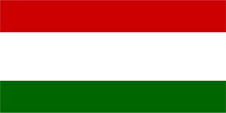
Merchant flag,
doubtful,
ratio = 1:2,
Source, by: Wikipedia (EN)



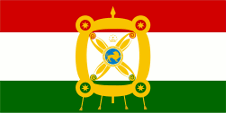
Flag of the President,
ratio = 1:2,
Source, by: Fry1989, Public domain,
via Wikimedia Commons




The territory of today's Tajikistan belonged to the Khanate of Bukhara until 1920, but was a protectorate of Russia from 1868, belonged to the Bukhara People's Socialist Republic from 1920 to 1924, and also to the Turkestan Autonomous Soviet Republic until 1924 and as an autonomous republic to the Uzbek Soviet Socialist Republic from 1924 to 1929.
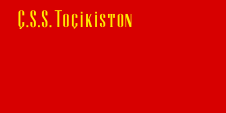
1931–1935,
Flag of the Tajik Soviet Socialist Republic,
ratio = 1:2,
Source, by: World Statesmen



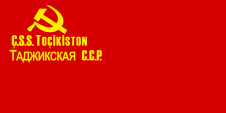
1935–1937,
Flag of the Tajik Soviet Socialist Republic,
ratio = 1:2,
Source, by: World Statesmen



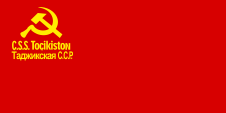
1937–1938,
Flag of the Tajik Soviet Socialist Republic,
ratio = 1:2,
Source, by: World Statesmen



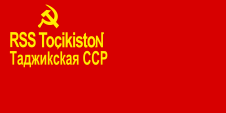
1938–1940,
Flag of the Tajik Soviet Socialist Republic,
ratio = 1:2,
Source, by: World Statesmen



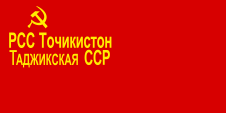
1940–1953,
Flag of the Tajik Soviet Socialist Republic,
ratio = 1:2,
Source, by: World Statesmen



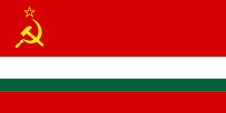
1953–1991,
Flag of the Tajik Soviet Socialist Republic,
ratio = 1:2,
Source, by: World Statesmen



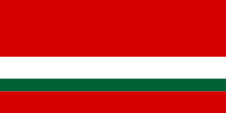
1991–1992,
Flag of the Republic of Tajikistan,
ratio = 1:2,
Source, by: Flags of the World




The current flag of Tajikistan was introduced on 24th of November in 1992. It shows three horizontal stripes in red, white and green in a ratio of 2:3:2. The colours of the flag appear to be defined, but no legal basis could be found, no law and no regulation. The colours are defined in hex colour space, among others: Red = #CC0000, Yellow = #F8C300 and Green = #006600, which would correspond to the following colours in the Pantone colour space: Red = pt 485 c, Yellow = pt 123 c and Green = pt 364 c. In the centre of the wide white central stripe is placed a stylised golden crown and above it seven golden stars arranged in a semicircle.
There are several explanations for the design and the meaning of the colours:
• The "Regulation on the State Flag of the Republic of Tajikistan", adopted on 24th of November in 1992 describes the flag as a symbol of the indestructible alliance of workers, farmers and intellectuals. The workers are symbolized by red, the farmers by green and the intelligentsia by white.
• Red stands for the country, white stands for cotton, which is so important for the country, and green stands for the other agricultural products.
• Red stands for fire, white stands for water and green stands for the earth.
• Red stands for the unity of the people and brotherhood with other nations, white stands for cotton but also the snow in the mountains, green represents the fertile valleys of the country.
• Red, white and green are also the colors of Iran, and in this way the kinship of the Tajiks with the Iranians (Persians) is expressed.
• The three stripes represent the three great eras: the era of the golden age, the struggle and the downfall.
• When designing the flag, the upper three stripes of the flag of the former Soviet Republic of Tajikistan served as a template.
• The colors are historically based and show the colors of the country's former estates, red as the color of the military nobility, symbolizing military bravery and self-sacrifice in the name of high ideals, white as the color of the Islamic clergy, representing spirituality, moral purity and holiness, and green as the color of the free community members from the ranks of cattle breeders and farmers, symbolizing nature, youth and prosperity.
• In the Pamirs, to this day, red symbolizes happiness, well-being and joy, white stands for purity and clarity and green for youth and prosperity.
• Red stands for freedom and independence, white for peace and tranquility and green for youth and prosperity.
• The flag shows a total of seven stars. For the creators of the flag, these originally represented seven very well-known Persian-Tajik poets. Later, the "seven auspicious spaces of the Aryan expanse" were interpreted into it, and today it is seen as the seven historical and cultural regions of modern Tajikistan: Sogd, Zarafshan, Hissar, Garm, Vakhsh, Khatlon and Badakhshan.
• The stylized crown on the flag (it can also be found in the coat of arms), represents the Tajik people, who call themselves "Tojik". In the word "tojik" you can find the word "toj", which means "crown".
• The crown and also the stars symbolize the independence of the country.
• The crown is considered a symbol of the basic principle of the old Persian religion of Zoroastrianism (Zarathustra).
• In Tajik tradition, the seven stars represent the seven wonderful orchards of heaven, which are separated by seven mountain peaks, each with a shining star at the top. Therefore, the number seven is interpreted as the number of perfection, the embodiment of luck and the key to success.
• The seven stars stand for the Holy Spirit and the six guardian spirits of cattle, fire, metal, earth, water and plants.
The Tajiks did not have their own state until the modern days, so the flag of the respective sovereign was used in the times before. The Tajik Soviet Socialist Republic, which was founded not until 1929, used the usual communist red flag with the country's name, which was supplemented by the hammer and sickle in 1935. On 20th of March in 1953, a new flag was adopted for the Tajik Soviet Socialist Republic. It showed four horizontal stripes in red, white, green and red in a ratio of 5:2:1:2 and in the upper corner the hammer, sickle and Soviet star in gold. The first flag, which was used between 1929 and 1931, was also plain red, but featured an elaborately designed disc in the upper corner with the country's name running all around it and a Soviet-styled coat of arms with a hammer and sickle in the middle. A presidential flag was introduced not until 2006. It is based on the national flag, but shows in the middle, above everything, the 'Derafsh Kaviani', the royal standard of the Sassanids.
The English-language Wikipedia shows a flag without a coat of arms, which is referred to as a civil flag and merchant flag, thus a flag that can be used by anyone and underlines the non-governmental character of a private ship at sea. This flag would therefore partially compete with the principle of the national flag. The actual existence of such a flag has not yet been proven.
Source:
Wikipedia (RU),
Wikipedia (EN),
Wikipedia (DE),
Flags of the World,
Flaggen-Atlas Erde,
Flaggen und Coat of arms of the Welt,
Flaggen Enzyklopädie

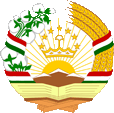
since 1993,
Coat of arms of Tajikistan,
Source, by: mfa.tj
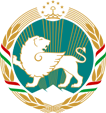
1992–1993,
Coat of arms of Tajikistan,
Source, by: Leonid 2, Public domain,
via Wikimedia Commons
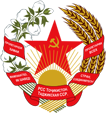
1940–1992,
Coat of arms of the Tajik Soviet Socialist Republic,
Source, by: TheSign 1998, Public domain,
via Wikimedia Commons

The today's coat of arms of Tajikistan was introduced on 28th of December in 1993 and shows a golden sun rising over snow-capped mountains, above it a stylized golden crown and above it seven golden stars arranged in a semicircle, surrounded by a wreath of cotton branches and ears of grain, which are surrounded by a red, white and green ribbon. In the lower part a golden book on a blanket.
There are some explanations about the design:
• The stylized crown on the flag (it can also be found in the coat of arms), represents the Tajik people, who call themselves "Tojik". In the word "tojik" you can find the word "toj", which means "crown".
• The crown and also the stars symbolize the independence of the country.
• The crown is considered a symbol of the basic principle of the old Persian religion of Zoroastrianism (Zarathustra).
• In Tajik tradition, the seven stars represent the seven wonderful orchards of heaven, which are separated by seven mountain peaks, each with a shining star at the top. Therefore, the number seven is interpreted as the number of perfection, the embodiment of luck and the key to success.
• The seven stars stand for the Holy Spirit and the six guardian spirits of cattle, fire, metal, earth, water and plants.
Source:
Wikipedia (RU),
Wikipedia (EN),
Wikipedia (DE),
Flags of the World,
Flaggen und Coat of arms of the Welt


Aircraft Roundel,
Source, by: Wikipedia (EN)

Location:
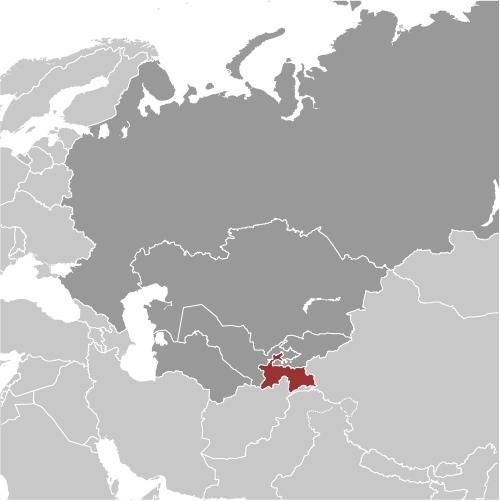
Source: CIA World Factbook
Map of the country:
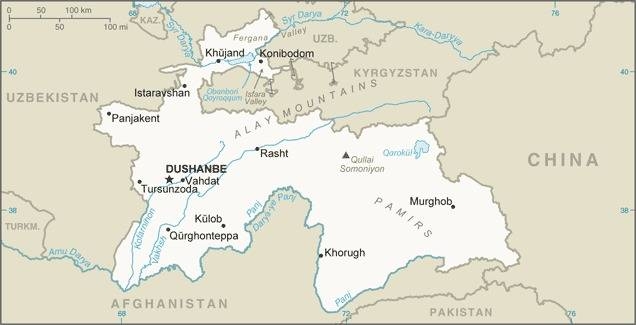
Source: CIA World Factbook

Area: 55.251 square miles
Inhabitants: 10.000.000 (2022), thereof 84,3 % Tajiks, 13,8 % Uzbeks, 0,8 % Kyrgyz, 0,5 % Russians, and also Tatars, Ukrainians and Germans
Religions: 90% Muslims (mostly Sunnis), 3,1 % Christian, and some Baha'is and Zoroastrians
Density of Population: 181 inh./sq.mi.
Capital: Duschanbe (name 1929–1961: Stalinabad), 1.201.800 inh. (2022)
official Languages: Tajik, Russian
other Languages: Uzbek
Currency: 1 Somoni (TJS) = 100 Diram
Time Zone: GMT + 5 h
Source:
Wikipedia (D)

antiquity · settlement by Iranian peoples (Baktrians, Sogds)
328/329 B.C. · Alexander the Great submits the Baktrians and Sogds and conquers parts of the today’s western Tajikistan
ca. 3rd century B.C. · the today’s Tajikistan belongs to the Greek-Baktrian Empire (Diadochs)
ca. 2nd century B.C. · first mention of the Tajiks ("Ta-Hia") in Chinese sources
4th–6th century A.D. · invasion of the White Hus (Hephtalits), the today’s western Tajikistan belongs to the Empire of the Hephtalits
560 A.D. · subjection by Turk nations
700–750 · conquest by the Arabs, islamization
874–999 · under the rule of the Persian Samanits, part of the Arabian Califate
11th century · to the Empire of ther Karakhanids
1220–1280 · under rule of the Huns
14th century · to the Empire of Timur Lenk
14th–15th century · to the Empire of Mawarannhar (Samarkand)
17th century · to the Khanate of Buchara
1868 · the Khanate of Buchara becomes a Russian protectorate
1876 · the northern Pamir Mountains Region comes to Russia
1895 · the central Pamir Mountains Region (Badakhshan) comes to Russia
1917–1920 · civil war between Bolshevists, Anti-Bolshevists and nationalists
30th of April 1918 · establishment of the Turkestan Autonomous Soviet Socialist Republic within Soviet Russia (ca. today’s Turkmenistan, Uzbekistan, southern Kazakhstan, western Tajikistan)
1920 · ultimate erection of the Soviet dictatorship
30th of December 1922 · foundation of the Soviet Union (USSR)
14th of October 1924 · dissolution of the Turkestanian Autonomous Socialistic Soviet Republic, separation in the Soviet Republics of Kyrgyzstan, Uzbekistan and Turkmenistan, cede of territories to Kazakh ASSR, Tajikistan ist first of all an autonomous socialist republic within Uzbekistan
5th of December 1929 · separation of Tajikistan from Uzbekistan as an own socialistic soviet republic, annexion of the northern and central Pamir Mountains Region (Badakhshan)
1941–1945 · forced settlement of Russia-Germans because of alleged collaboration with Germany
1990 · declaration of sovereignty
9th of September 1991 · declaration of independence, Tajikistan becomes a member of the CIS
31st of December in 1991 · the Soviet Union dissolves
1992–1997 · civil war between government and ethnic, religious and political groups
1993 · ban of four oppositional parties
2001 · temporary stationing of French and US troops in Chorugh and Dushanbe
Source:
Atlas zur Geschichte,
World Statesmen,
Wikipedia (D)

The name "Tajikistan" is to understand as "Land of the Tajiks", but in the local language "Tajikistan" means "Land of the settlers". Other sources see the "Tajiks" as the "crowned ones", because they call themselves "Tojik" and in the word "tojik" you can find the word "toj", which means "crown". It is assumed that some Tajiks used to wear crowns and that this is how the name of the people and country came about. Another theory assumes that the name "Tajik" was given to the Tajiks by the neighboring Turkic peoples and would mean "Muslim". It is also assumed that the Arabic tribal name "Tayyi" (and from it "Tajik") is a name used by Turkic peoples for Persians.
Source:
Flags of the World,
Wikipedia (D),
Die Völker der Erde,
Handbuch der geographischen Namen


![]()

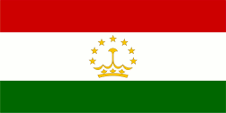

















![]()
